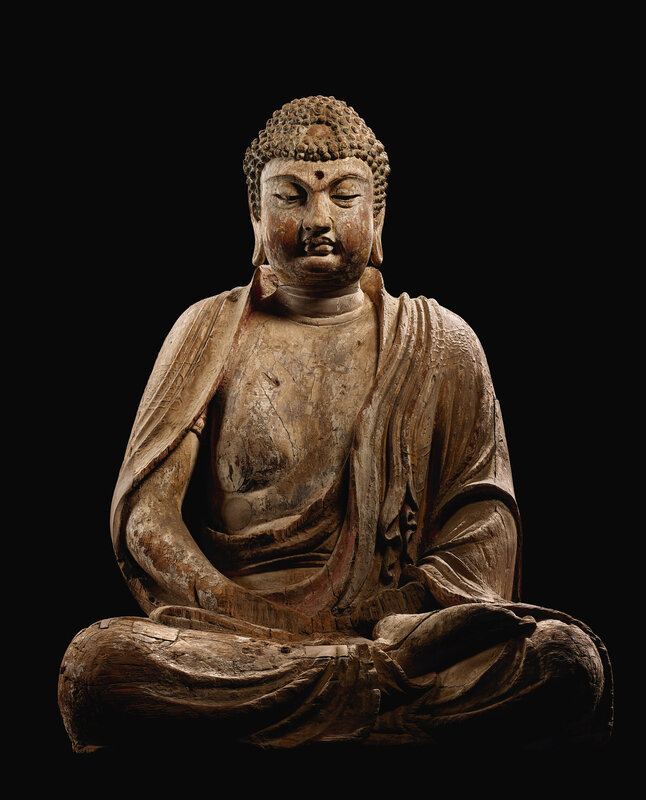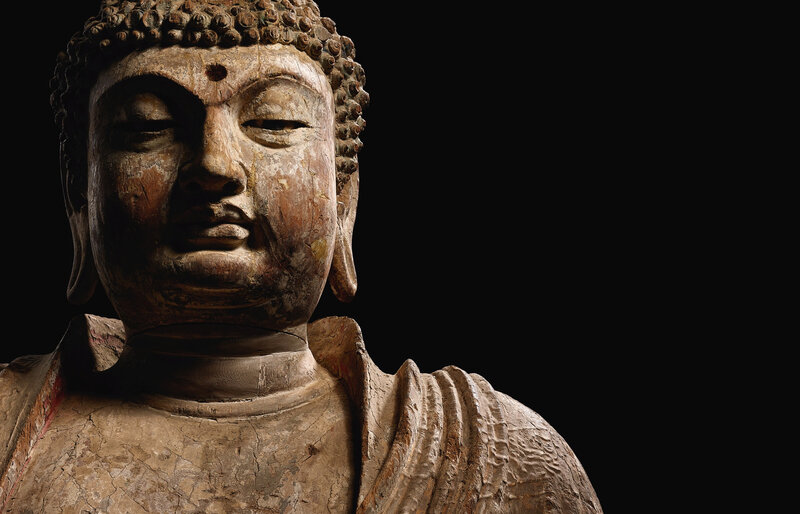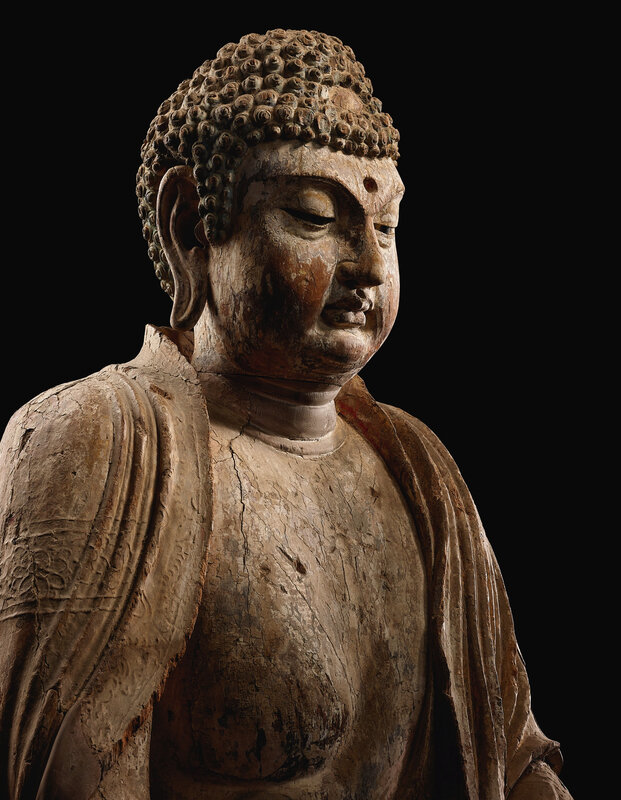Sotheby's. An Important Collection of Chinese Ceramics, Hong Kong, 08 Oct 2019
An extremely rare large polychrome wood figure of Shakyamuni Buddha, Jin dynasty (1115-1234)






Lot 3629. An extremely rare large polychrome wood figure of Shakyamuni Buddha, Jin dynasty (1115-1234); 122 cm, 48 in. Estimate 16,000,000 — 18,000,000 HKD (2,037,280 - 2,291,940 USD). Lot Sold 16,975,000 HKD (2,161,427 USD) . Courtesy Sotheby's.
superbly and sensitively sculpted in the form of Shakyamuni Buddha seated in vajraparyankasana, portrayed with a sensuous full face accentuated with slender bow-shaped eyes and hooded eyelids casting a meditative and powerful aura with downcast pupils, all below well-defined arched eyebrows flanking a central recess for an urna, the curved contours of the eyebrows juxtaposed with the prominent nose above softly and realistically delineated lips, all framed by neatly arranged rows of ringlet curls and a pair of long pendulous earlobes, the domed head further depicted with an ushnisha, the dignified and sublime figure rendered clad in long flowing robes subtly picked out in relief with floral borders, the voluminous drapery elegantly cascading in folds and baring the upper right torso, the reverse of the head and torso left with a rectangular aperture, traces of original polychrome pigments.
Provenance: Acquired in 1994.
Exhibited: The Splendour of Buddhist Statuaries. Chinese Buddhist Wooden Sculpture from Sung and Yuan Dynasties, National Museum of History, Taipei, 1997, pp. 34-37.
Literature: Bulletin of the National Museum of History, 1997, vol. VII, no. 6, cover and inside cover.
Spiritual Monumentality in a Turbulent Era
This large and impressive sculpture of Shakyamuni Buddha, imbued with the uttermost spirituality and tranquillity, provides a window into a golden age of Buddhist history in China, when Buddhism flourished amidst an unstable backdrop of chaos and war under the Jin dynasty (1115-1234), and a profusion of sculptures was created in wood, particularly for the pre-eminent centres of religious activity in Taiyuan and Wutaishan. Naturalistic in its sensitive rendering of the figure, but carved on a grand scale, the full-bodied image is conveyed with aristocratic countenance on the softly delineated face, set in an expression of intense serenity. The treatment of the long flowing robes, picked out in varying levels of relief, produce a dramatic dichotomy between shadow and highlight, captivating the viewer with an impression of realism and deep humanity. Preserved in good condition after nearly a millennium, with traces of its original pigments, it is a sublime creation.
The depth of support for Buddhism in the Jin dynasty is evident from the numbers of surviving sutras carved on stone tablets, and by the ambitious production of a new official printed edition of the Buddhist canon, completed in Shanxi in 1192, as expounded by Tao-chung Yao, ‘Buddhism and Taoism under the Chin’, in Hoyt Cleveland Tillman and Stephen H. West (eds), China under Jurchen Rule: Essays on Chin Intellectual and Cultural History, New York, 1995, p. 174. It is also evident from the sheer quality and stature of the surviving sculptures of the period. Such large wooden statues, originally with rich painted surfaces, were created for Buddhist temples in north China under the different dynasties that ruled in the 10th-13th centuries. Many temples in northern China were as extensive as palaces, and contained a series of courtyards with magnificent buildings devoted to worship, teaching and monks’ living quarters. The Jurchen rules of the Jin dynasty built on this tradition, gradually adopting Buddhism as the state religion in place of shamanism, and establishing a rich legacy of temples, tombs and artefacts. The deeply carved drapery and the heavy ornamentation on figures of this size, coupled with the preserved pigments, hint at the original sumptuousness and overwhelming visual effect that awaited temple visitors. They would have encountered this image in an elaborate stage set with painted murals covering the walls, along with many other sculptures of deities and luohan, all brightly coloured and gilded.
Carved wood Buddhist figures from the Jin dynasty, of which this is such a fine example, reveal the deep level of influence from the artistic style of the Indian Gupta Empire (320-647), itself imbued with resonances of the Hellenistic tradition. Looking at the Buddha, the eye is drawn not only to the form of the figure itself, but also to the graceful folds of the robes, distinctly Hellenistic in their adherence to the contours of a realistically conceived body as they flow freely down. The treatment of the dynamic muscular body, gentle S-curves and features such as the exposed chest do not stem from Han Chinese traditions, where little of the naked body was ever depicted, but pay homage to the external influences that crossed the Silk Road to China during and before the Tang dynasty. The carvers of the Jin dynasty were not only just inspired by this tradition, but further developed it in their own unique style, as demonstrated by areas such as the face, where the plumper, more fleshier treatment of the expression assumed a greater delicacy of articulation, and a softness of modelling matching the outlook of the confident, culturally sophisticated but politically inept court. It epitomises the new humanism imbued in Buddhist sculpture from the 11th-12th century onwards. The figure is majestic, yet it also exudes a benign calm and warmth that draw in the viewer, creating an impression of greater approachability and emotional connection.
Other large scale wood sculptures from the Jin dynasty are known, mostly preserved in museum collections, but of these, the vast majority are images of bodhisattva, particularly of Avalokiteshvara. It is much rarer to find a sculpture of Shakyamuni Buddha. The only other recorded example appears to be one sold at Christie’s Hong Kong, 30th/31st October 1994, lot 388, and included in the same landmark exhibition as the current lot – The Splendour of Buddhist Statuaries. Chinese Buddhist Wooden Sculpture from Sung and Yuan Dynasties, National Museum of History, Taipei, 1997, pp. 38-39, and illustrated on the cover.
Of the famous life size wood sculptures of bodhisattvas preserved in museum collections, one of the finest is the large Song – Jin dynasty wood figure of Avalokiteshvara, illustrated in Masterworks of Asian Art. The Cleveland Museum of Art, Cleveland, 1998, p. 56 (fig. 1). It shares several distinct stylistic features with the current lot, especially the treatment of the face, softly carved with fleshy modelling, skilful rendering of naturalistic details including the creases at the mouth, the slightly plump cheeks, and the prominent brow. Several features, including the precise manner in which the upper torsos are rendered on both figures, through skilful curved lines highlighting the exposed muscle, are so similar that it could be conjectured that both figures were created by the same carver or workshop. Compare also the treatment of the face, robes and exposed body on a monumental polychrome wood figure in the Nelson Atkins Museum of Art, Kansas, illustrated in Robert E. Fisher, Buddhist Art and Architecture, London, 1993, pl. 106, and on the cover. See also similar stylistic elements on the famous pair of large wood figures of bodhisattvas in the Royal Ontario Museum, Toronto. Reportedly found in Linfen, Shanxi province, before they entered the George Crofts collection, one of them is notable for the dedicatory inscription on the inside dating it to 1195; see Denise Patry Leidy and Donna Strahan, Wisdom Embodied. Chinese Buddhist and Daoist Sculpture in the Metropolitan Museum of Art, New York, 2010, p. 19, fig. 20.

fig. 1. Eleven-headed wood figure of Avalokiteshvara(detail), late Northern Song – Jin dynasty. Purchase from the J. H. Wade Fund. Courtesy of Cleveland Museum of Art, Cleveland.
For other examples of Jin wood carved figures sold at auction, see a Liao – Jin polychrome wood figure of Water Moon Guanyin from the collections of Martin Erdmann and Brodie Lodge, sold in our London rooms, 7th June 1988, lot 48, to Eskenazi, and recently sold at Christie’s Hong Kong, 30th May 2018, lot 2858, and a large Song – Jin dynasty figure of a Bodhisattva from the collection of Robert Hatfield Ellsworth, sold at Christie’s New York, 17th March 2015, lot 58.

/https%3A%2F%2Fprofilepics.canalblog.com%2Fprofilepics%2F1%2F0%2F100183.jpg)
/https%3A%2F%2Fstorage.canalblog.com%2F03%2F02%2F119589%2F96711876_o.jpg)
/https%3A%2F%2Fstorage.canalblog.com%2F11%2F31%2F119589%2F94773502_o.jpg)
/https%3A%2F%2Fstorage.canalblog.com%2F20%2F83%2F119589%2F94772815_o.jpg)
/https%3A%2F%2Fstorage.canalblog.com%2F26%2F72%2F119589%2F75604929_o.jpg)
/https%3A%2F%2Fstorage.canalblog.com%2F59%2F60%2F119589%2F26458628_o.jpg)


/http%3A%2F%2Fstorage.canalblog.com%2F75%2F15%2F119589%2F129091868_o.jpg)
/http%3A%2F%2Fstorage.canalblog.com%2F68%2F83%2F119589%2F127764995_o.jpg)
/http%3A%2F%2Fstorage.canalblog.com%2F35%2F16%2F119589%2F126967238_o.jpg)
/http%3A%2F%2Fstorage.canalblog.com%2F80%2F84%2F119589%2F126966655_o.jpg)